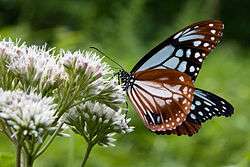Parantica sita
| Chestnut Tiger | |
|---|---|
 | |
| Scientific classification | |
| Kingdom: | Animalia |
| Phylum: | Arthropoda |
| Class: | Insecta |
| Order: | Lepidoptera |
| Family: | Nymphalidae |
| Genus: | Parantica |
| Species: | P. sita |
| Binomial name | |
| Parantica sita (Kollar, 1844) | |

The Chestnut Tiger (Parantica sita) is a butterfly found in Asia that belongs to the Crows and Tigers, that is, the Danaid group of the Brush-footed butterflies family.
Description
Wings elongate, almost as in Idea. Upperside of forewing black or fuliginous black, with the following bluish-white subhyaline markings. A streak from base in interspace 1b, very broad streaks filling the basal three-fourths of interspace 1, and the whole of the cell, five very large quadrate discal spots, two long preapical streaks, three shorter streaks above them, a sub-terminal series of more or less rounded spots decreasing in size anteriorly and curved inwards opposite apex, and an incomplete subterminal series of smaller spots. Hindwing chestnut-red, with subhyaline streaks and spots as follows: streaks from base, not reaching the termen in interspaces 1 a and 1 b, two broad streaks united to near their apex in interspace 1, a streak filling the cell, and beyond it a discal series of large inwardly pointed elongate spots and incomplete ill-defined subterminal and terminal series of spots. Underside similar, the markings clearer and more complete. Antennae black; head and thorax black, spotted with white; abdomen from brown to bright ochraceous, beneath whitish. Male secondary sex-mark in form 2.[1]
Distribution
Along the Himalayas and into the Malayan region. N. Pakistan, Kashmir, N.India, Sikkim, Tibet, China, Taiwan, Korea, Japan, Malaya, Ussuri, Sakhalin, Indo-china.
Life history
Larva: On emergence a dirty white colour with transverse lines on each segment, two somewhat long and thin tentacles or processes on the third, and two shorter ones on the twelfth segment. When full-fed the larva is about an inch and a half long, the ground colour is of a pale yellowish green, with two rows of dorsal and a row on each side of lateral yellow spots, the head is black with grey spots on the face, the legs black.[1]
Pupa: pale emerald-green with golden-yellow spots. From eggs laid in September the imago issued in the following April.[1]
Food plants: Marsdenia roylei, Wright. Asclepiaceae.[1] Asclepias curassavica, Cynanchum caudatum, C. grandifolium, C. sublanceolatum, Hoya carnosa, Marsdenia tinctoria, M. tomentosa, Metaplexis spp., Tylophora aristolochioides, T. floribunda, T. japonica, T. ovata, T. tanakae.[2]
Cultural references
- In March 1987 DPR Korea issued a postage stamp depicting Parantica sita.
See also
References
- 1 2 3 4 Bingham, C.T. (1905). The Fauna of British India, Including Ceylon and Burma Butterflies. 1 (1st ed.). London: Taylor and Francis, Ltd.
- ↑ Markku Savela. Butterflies of the world Accessed November 2006